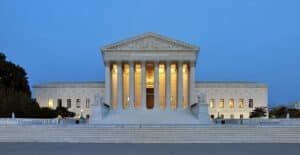
In reviewing the federal eviction moratorium, a majority of the U.S. Supreme Court objected to “a breathtaking amount of authority” granted to the CDC. Photo by Joe Ravi | CC BY-SA 3.0
In 1944, Congress passed legislation authorizing the Centers for Disease Control and Prevention to make and enforce regulations necessary to control communicable diseases, including authority to require “inspection, fumigation, disinfection, sanitation, pest extermination, destruction of animals or articles found to be so infected or contaminated as to be sources of dangerous infection to human beings, and other measures.”
The CDC rarely invoked this statutory authority during the last 76 years, and it had never used it to impose a residential eviction moratorium until the COVID-19 pandemic. The 1944 legislation does not specifically authorize the CDC to impose an eviction moratorium, but neither does it specifically deny such authority. Last month in Alabama Association of Realtors v. Department of Health and Human Services, the U.S. Supreme Court concluded that the eviction moratorium was beyond the CDC’s statutory authority.
The CDC moratorium’s history is of interest. Congress recognized in March 2020 that the COVID-19 pandemic was likely to cause housing disruptions for unemployed workers unable to pay rent, and that evictions would cause over-crowded dwellings that could spread COVID-19. Congress passed legislation imposing a 120-day eviction moratorium on housing benefitted by federal assistance and loan programs.
After Congress’s moratorium expired in July 2020, the CDC imposed a broader moratorium that applied to all residential properties nationwide until Dec. 31, 2020. The CDC moratorium threatened violators with harsh criminal punishment, including fines and imprisonment.
Congress extended the moratorium to Jan. 31 of this year, but again let it expire. The CDC extended the moratorium to March 31, then June 30, and eventually to July 31, relying on the 1944 legislation. Associations of Realtors and property managers in Alabama and Georgia challenged the CDC moratorium in the D.C. federal district court. The district court ruled in May that the moratorium was invalid, but placed a stay on its ruling, allowing the moratorium to continue pending appeal.
A Question of CDC’s Authority
After a federal court of appeals upheld the stay, the Realtors and property managers appealed to the Supreme Court, which issued a split decision in early July allowing the moratorium to continue. Four Supreme Court justices voted to preserve the stay, and four justices voted to vacate the stay so evictions could proceed despite the moratorium.
Justice Brett Kavanaugh’s unusual concurring opinion tipped the balance toward preserving the moratorium. He wrote that although the moratorium was beyond the CDC’s authority, the moratorium was scheduled to expire on July 31 anyway, and he wanted to allow more time for distribution of rental assistance funds. Justice Kavanaugh warned, however, that another moratorium extension required action by Congress.
After the moratorium expired as scheduled on July 31, the CDC extended it again to Oct. 3, and reserved the right to further extensions. The Realtors and property managers returned to federal district court, where the judge agreed that the moratorium was invalid, but declined to vacate the stay because existing appellate court rulings had upheld the stay. The court of appeals also declined to vacate the stay. Thus, the case returned to the Supreme Court, several weeks after its split decision allowed the moratorium to remain in place until July 31.
Two Conflicting Visions
The CDC was less successful at its second appearance before the Supreme Court. Six of nine justices agreed with the Realtors and property managers that the CDC had overstepped its authority under the 1944 legislation. The court noted that the federal government claimed “a breathtaking amount of authority” based on the 1944 legislation, which would give the CDC virtually unlimited power to prevent disease. The court vacated the stay, effectively nullifying the CDC moratorium. However, the court’s ruling does not prevent Congress from reimposing the moratorium. Nor does it prevent state and local governments from imposing their own eviction moratoria, as Acting Mayor Kim Janey recently announced in Boston.

Christopher Vaccaro
Justice Stephen Breyer, joined by two other justices, dissented. His interpretation of the 1944 legislation was diametrically opposed to that of the six-justice majority. He maintained that the plain meaning of the statute (which does not specifically authorize an eviction moratorium) “includes eviction moratoria necessary to stop the spread of diseases like COVID-19.” Justice Breyer would have preserved the moratorium.
The Supreme Court’s majority opinion, and Justice Breyer’s dissent, offer two conflicting visions on the scope of regulatory authority. One would limit federal administrative agency powers to those specifically granted in legislation. The other would confer broad authority upon such agencies, perhaps even authority that was not contemplated when Congress passed the relevant legislation decades ago.
Christopher R. Vaccaro Esq. is a partner at Dalton & Finegold LLP in Andover. His email address is cvaccaro@dfllp.com.






